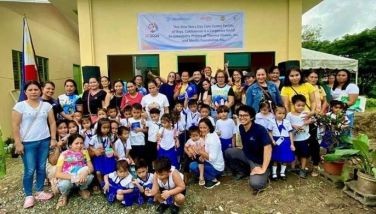Immersion as mode of delivery
We must never forget the three reasons we added three years (Kindergarten and Grades 11 and 12) to the basic education cycle of students in public schools. (Private school students have always had more than ten years of pre-university education.)
First, we wanted to make our college graduates internationally competitive. That means that even public high school graduates had to enter college with at least 12 years of pre-university education, like everybody else in the world. Even before DepEd added the three years to basic education, CHED had already decided to change the college curriculum to make it comparable to those of ASEAN countries and the rest of the world. Before K to 12, high school graduates were not ready to tackle the enhanced college curriculum. (Engineering majors, for example, had to waste their college time studying calculus.)
Second, we wanted to help those who finished high school but did not go to college. Enterprises did not want to employ them because they were too young to seek employment, and more important, they did not have the skills to be employed. To get those skills, they had to pay their way through TESDA training.
Third, we wanted to increase the number of entrepreneurs in the country, because small and medium enterprises (SMEs), as various international conferences have pointed out, “play a key role in transition and developing countries. These firms typically account for more than 90% of all firms outside the agricultural sector, constitute a major source of employment and generate significant domestic and export earnings. As such, SME development emerges as a key instrument in poverty reduction efforts.” High school graduates who could not continue to college or were not hired by enterprises should be able to put up their own businesses.
The Academic track of Senior High School takes care of the first objective. Using a combination of core subjects that everyone in college needs (roughly equivalent to the current General Education Curriculum) and specialized subjects that particular majors demand (such as calculus for engineering students), this track ensures that K to 12 graduates can study anywhere in the country or even abroad without being disadvantaged.
Immersion as a subject in the Academic track is meant to prepare the student for college. That is why it is only one of four options for the “Work Immersion / Research / Career Advocacy / Culminating Activity” subject. Depending on what the student wants to major in in college, immersion could be more useful than research or some other activity. That is why immersion is given only 80 hours at most in the Academic track.
To answer the second objective of the K to 12 reform, students who are not thinking of going to college immediately after high school need to have employable skills. In practice, the institutional way of proving that one has skills is to have National Certificates (NCs). These are given by TESDA. DepEd and TESDA got together to formulate the curriculum for the Technical-Vocational-Livelihood track.
This is where the word “immersion” has a different meaning from its meaning in the Academic track.
Section 6 of RA 10533 (the K to 12 law) made it compulsory for DepEd, CHED, and TESDA to consult business chambers in the formulation of the curriculum. The reason is that it is the employers that know what skills they want. The mismatch that characterized education and industry in the past was due to a simple lack of communication: educators hardly ever asked employers what students should be learning. The law makes sure that this does not happen again.
To put flesh into that provision of the law, the government signed a “Joint Declaration of Intent” with the Federal Republic of Germany, since Germany has the best system of Tech-Voc education. The declaration stated, among other things, that “the participants intend to support the integration of dual training into the educational system of the Republic of the Philippines; with the Technical Education and Skills Development Authority (TESDA) as lead implementing agency, and in close coordination with the Department of Education (DepEd), especially on its K to 12 program.”
Since it is the legal voice of Philippine business, the Philippine Chamber of Commerce and Industry (PCCI) signed Memorandums of Understanding (MOUs) with both TESDA and DepEd.
The MOU between PCCI and DepEd states, among other things, that “the DepEd shall, whenever appropriate and practical, allow SHS offering the TVL track to use Dual Training as their mode of delivery” and “whenever appropriate and practical, allow Dual Training as a mode of delivery in any of the Track Subjects, provided that the standards expected for these subjects as detailed in the relevant K to 12 Curriculum Guides of the DepEd are sufficiently covered.”
This “mode of delivery” is what is referred to by the second meaning of “immersion.”
If we go to the DepEd website (“K to 12” then “Curriculum Guides” then “Senior High School Specialized Subjects” then “Technical-Vocational-Livelihood Track”), we can see why students have to be immersed in workplaces to get the skills that will give them NCs.
(To be continued)
- Latest





























